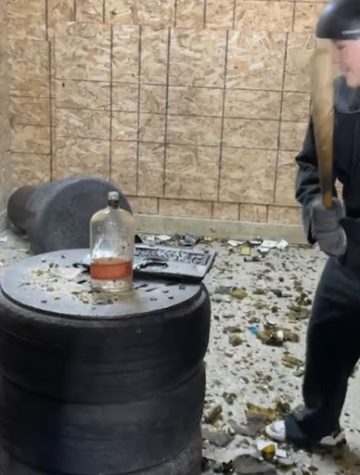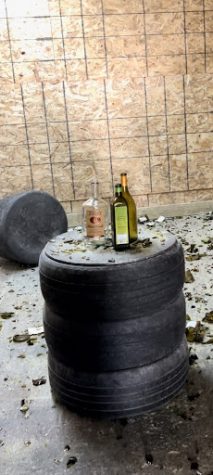‘For Me and For Them’: Sophia’s Path-making Essay
Black and white. They’re arguably the most recognizable opposites and perhaps the most complimentary. There’s the common phrase “opposites attract”, but for some reason there is no phrase describing their cohesive beauty for how they work together. The stark contrast between opposites is what generates their codependence and reliance on one another. In essence, a pair of opposites are bonded to each other, both existing in a symbiotic relationship to survive. For every light, there’s a dark, for every sunrise there’s a sunset, and with every destruction, there’s a rebuild.

The first observation I see is the contrast of light and dark. The black of the tires and punching bag and the bright white of the overhead light. For an objectively messy and sketchy room, light illuminates every corner, so all the ruin and rubble is exposed. The room is broken and bare and its features are stripped. This scene of chaos is decorated with scattered broken glass, a ruined table and a punching bag abandoned in the corner. Ironically, for this place that seems to be destroyed so heatedly, we are surrounded by a coldness – the glass, the cement floor, and little to no insulation in the raw ceiling or plywood walls. Each element contributes to the eerie feel of the place, whether it be the abandoned nature of it or the shocking mess.
We are inherently drawn to chaos. Whether it be to start it, understand it, observe it, control it or draw from it, people become involved in messes. Perhaps it is the knowledge that something will be generated in the wake of the destruction that attracts attention. But maybe it’s our urge to leave an everlasting mark by destroying something that makes everyone participate. Because even despite chaos’s stigma of leaving disaster in its wake, we are still attracted to it like moths to a flame.
I know I was drawn into chaos. That is why I found myself looking at this scene. I had no innate purpose to be in a rage room, and yet I found myself compelled to join anyway. I’m not quite sure whether it was the anticipation of the chaos itself that made me sign the waiver allowing me to go, or the healing and release of my mind that I hoped would come after. Nevertheless, the destruction we find ourselves dissecting is of my own doing.

And yet, from the destruction of that room we can find a makeshift table, constructed from scrap tires and standing among the debris. The table is stable and solid, and the tires are somehow not popped from the sharp shards that surround them. It seems large in comparison to the bottles atop it, and even larger when compared to the shards on the floor. But when you take away the clutter, and look at the rest of the image, the structure and bones of the room remain, and are only shrouded by the mess. When looking at its framework, the room has the opportunity to become anything and foster everything – it’s essentially a blank canvas. From that image, we can take two messages: destruction breeds construction, and it doesn’t necessarily mean starting over.
To build a new architecture, you must clear the site. To destroy something, it must have already been built. We recycle old parts, only to break them down once again. It’s a cyclical loop that continues on and on, having no true start nor end. The subject in question is not always completely destroyed, and doesn’t always need to be to allow it to be reconstructed into something new. I refuse to say whether it will be made for better or worse, as who am I to judge the outcome of whatever gets created or destroyed. Perhaps the structure being demolished is a school, and the new one being built is a car dealership. I am just an observer commenting on how the two actions go hand in hand, and how their companionship is necessary. It’s not my place to predict or determine whether or not the action is good or bad, because my parameters are too broad to even allow me to begin to describe it. So, I am simply returning to my statement that destruction and construction are two unlikely coworkers, that together produce all we see today.
That point brings me back to the rage room. Every bottle I broke in it, was me releasing anger, which is the breeding ground for destruction. And yet, that anger is not a hindrance – it can be harnessed into an empowerment. I used that anger to shatter glass and destroy physical elements of the world, to help myself rebuild mental ones. That release, of the anger so many women feel from holding in our judgements and ideas, wasn’t just for me. Women everywhere who are held back, forced down and told that they are less, share that anger – they probably feel it more than I do. Though I didn’t see it then, I didn’t just go to that rage room to get angry and break shit for me. I did it for them too.









